
The alkali metals consist of the chemical elements lithium (Li), sodium (Na), potassium (K), rubidium (Rb), caesium (Cs), and francium (Fr). Together with hydrogen they constitute group 1, which lies in the s-block of the periodic table. All alkali metals have their outermost electron in an s-orbital: this shared electron configuration results in their having very similar characteristic properties. Indeed, the alkali metals provide the best example of group trends in properties in the periodic table, with elements exhibiting well-characterised homologous behaviour. This family of elements is also known as the lithium family after its leading element.
In chemistry, an alkali is a basic, ionic salt of an alkali metal or an alkaline earth metal. An alkali can also be defined as a base that dissolves in water. A solution of a soluble base has a pH greater than 7.0. The adjective alkaline, and less often, alkalescent, is commonly used in English as a synonym for basic, especially for bases soluble in water. This broad use of the term is likely to have come about because alkalis were the first bases known to obey the Arrhenius definition of a base, and they are still among the most common bases.

Caesium is a chemical element; it has symbol Cs and atomic number 55. It is a soft, silvery-golden alkali metal with a melting point of 28.5 °C, which makes it one of only five elemental metals that are liquid at or near room temperature. Caesium has physical and chemical properties similar to those of rubidium and potassium. It is pyrophoric and reacts with water even at −116 °C (−177 °F). It is the least electronegative element, with a value of 0.79 on the Pauling scale. It has only one stable isotope, caesium-133. Caesium is mined mostly from pollucite. Caesium-137, a fission product, is extracted from waste produced by nuclear reactors. It has the largest atomic radius of all elements whose radii have been measured or calculated, at about 260 picometers.
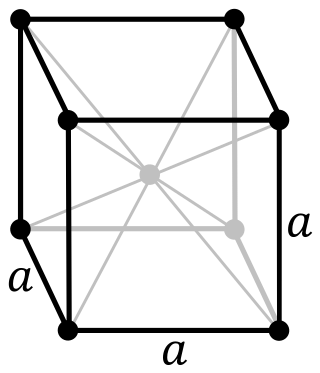
Francium is a chemical element; it has symbol Fr and atomic number 87. It is extremely radioactive; its most stable isotope, francium-223, has a half-life of only 22 minutes. It is the second-most electropositive element, behind only caesium, and is the second rarest naturally occurring element. Francium's isotopes decay quickly into astatine, radium, and radon. The electronic structure of a francium atom is [Rn] 7s1; thus, the element is classed as an alkali metal.
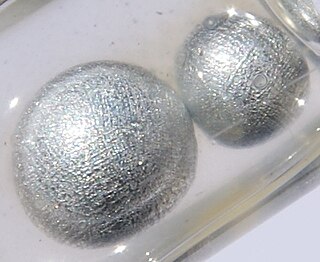
Potassium is a chemical element; it has symbol K and atomic number 19. It is a silvery white metal that is soft enough to easily cut with a knife. Potassium metal reacts rapidly with atmospheric oxygen to form flaky white potassium peroxide in only seconds of exposure. It was first isolated from potash, the ashes of plants, from which its name derives. In the periodic table, potassium is one of the alkali metals, all of which have a single valence electron in the outer electron shell, which is easily removed to create an ion with a positive charge. In nature, potassium occurs only in ionic salts. Elemental potassium reacts vigorously with water, generating sufficient heat to ignite hydrogen emitted in the reaction, and burning with a lilac-colored flame. It is found dissolved in seawater, and occurs in many minerals such as orthoclase, a common constituent of granites and other igneous rocks.

An alum is a type of chemical compound, usually a hydrated double sulfate salt of aluminium with the general formula XAl(SO
4)
2·12 H
2O, such that X is a monovalent cation such as potassium or ammonium. By itself, "alum" often refers to potassium alum, with the formula KAl(SO
4)
2·12 H
2O. Other alums are named after the monovalent ion, such as sodium alum and ammonium alum.
A high-speed camera is a device capable of capturing moving images with exposures of less than 1/1 000 second or frame rates in excess of 250 frames per second. It is used for recording fast-moving objects as photographic images onto a storage medium. After recording, the images stored on the medium can be played back in slow motion. Early high-speed cameras used photographic film to record the high-speed events, but have been superseded by entirely electronic devices using an image sensor, recording, typically, over 1 000 frames per second onto DRAM, to be played back slowly to study the motion for scientific study of transient phenomena.
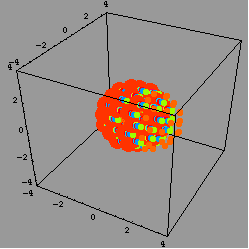
A Coulombic explosion is a condensed-matter physics process in which a molecule or crystal lattice is destroyed by the Coulombic repulsion between its constituent atoms. Coulombic explosions are a prominent technique in laser-based machining, and appear naturally in certain high-energy reactions.
Guanidine is the compound with the formula HNC(NH2)2. It is a colourless solid that dissolves in polar solvents. It is a strong base that is used in the production of plastics and explosives. It is found in urine predominantly in patients experiencing renal failure. A guanidine moiety also appears in larger organic molecules, including on the side chain of arginine.
Chelating resins are a class of ion-exchange resins. They are almost always used to bind cations, and utilize chelating agents covalently attached to a polymer matrix. Chelating resins have the same bead form and polymer matrix as usual ion exchangers. Their main use is for pre-concentration of metal ions in a dilute solution. Chelating ion-exchange resins are used for brine decalcification in the chlor-alkali industry, the removal of boron from potable water, and the recovery of precious metals in solutions.

Potassium azide is the inorganic compound having the formula KN3. It is a white, water-soluble salt. It is used as a reagent in the laboratory.
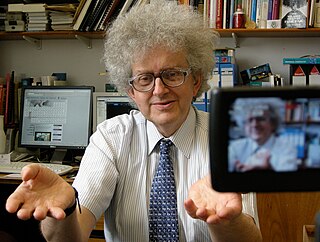
Periodic Videos is a video project and YouTube channel on chemistry. It consists of a series of videos about chemical elements and the periodic table, with additional videos on other topics in chemistry and related fields. They are published on YouTube and produced by Brady Haran, a former BBC video journalist, mainly featuring Sir Martyn Poliakoff, Peter Licence, Stephen Liddle, Debbie Kays, Neil Barnes, Sam Tang, and other scientists at the University of Nottingham.

Anita Sarkeesian is a Canadian-American feminist media critic. She is the founder of Feminist Frequency, a website that hosts videos and commentary analyzing portrayals of women in popular culture. Her video series Tropes vs. Women in Video Games, examines tropes in the depiction of female video game characters. Media scholar Soraya Murray calls Sarkeesian emblematic of "a burgeoning organized feminist critique" of stereotyped and objectified portrayals of women in video games.

Hyperloop is a proposed high-speed transportation system for both passengers and freight. The concept was documented by Elon Musk in a 2013 white paper, where the hyperloop was described as a transportation system using capsules supported by an air-bearing surface within a low-pressure tube. Hyperloop systems have three essential elements: tubes, pods, and terminals. The tube is a large, sealed low-pressure system. The pod is a coach at atmospheric pressure that experiences low air resistance or friction inside the tube using magnetic propulsion. The terminal handles pod arrivals and departures. The hyperloop, in the form proposed by Musk, differs from vactrains by relying on residual air pressure inside the tube to provide lift from aerofoils and propulsion by fans; however, many subsequent variants using the name "hyperloop" have been relatively traditional vactrains.

A splint is a simple piece of equipment used in scientific laboratories. Splints are typically long, thin strips of wood, about 6 inches (15 cm) long and ¼ inch (6 mm) wide, and are consumable but inexpensive. They are typically used for tasks such as lighting bunsen burners, as the length of the splint allows a flame to be lit without risk to the user's hand, should the burner flare back. Another use for splints are chemical identification of various gases, and splints are also used to teach simple chemical principles in schools and homes.

Brady John Haran is an Australian-British independent filmmaker and video journalist who produces educational videos and documentary films for his YouTube channels, the most notable being Computerphile and Numberphile. Haran is also the co-host of the Hello Internet podcast along with fellow educational YouTuber CGP Grey. On 22 August 2017, Haran launched his second podcast, called The Unmade Podcast, and on 11 November 2018, he launched his third podcast, The Numberphile Podcast, based on his mathematics-centered channel of the same name.

Tropes vs. Women in Video Games is a YouTube video series created by Anita Sarkeesian examining gender representation in video games. The series was financed via crowdfunding, and came to widespread attention when its Kickstarter campaign triggered a wave of online harassment against Sarkeesian, causing her to flee her home at one point. Released on the channel Feminist Frequency between March 2013 and April 2017, the series consists of eighteen episodes.
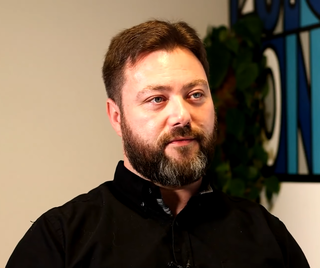
Carl Benjamin, also known by his online pseudonym Sargon of Akkad, is a British right-wing YouTuber and political commentator. A former member of the Eurosceptic UK Independence Party (UKIP), he was one of its unsuccessful candidates for the South West England constituency in the 2019 European Parliament election in the United Kingdom.

Pavel Jungwirth is a Czech physical chemist. Since 2004, he has been the head of the Senior Research Group at the Institute of Organic Chemistry and Biochemistry of the Czech Academy of Sciences. He has also been a professor in the Faculty of Mathematics and Physics at Charles University since 2000. He has also been a senior editor of the Journal of Physical Chemistry since 2009. He is popularly known for studying the explosive reaction between alkali metals, such as sodium and potassium, and water; his research on this subject indicates that these reactions result from a Coulomb explosion. He and his colleagues have also discovered a way to slow down this reaction, which they used to determine the source of a blue flash that is briefly produced during the reaction.
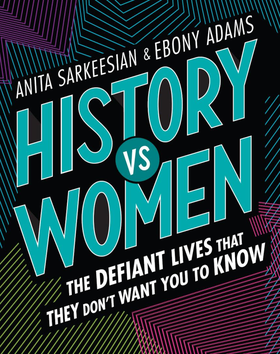
History vs Women: The Defiant Lives That They Don't Want You to Know is a 2018 book by Anita Sarkeesian and Ebony Adams, illustrated by T.S. Abe, which profiles 25 women from history. The subjects featured are from a diverse range of historical periods and locations, and include women who had a negative impact on the world. The book has received positive critical reception.
















